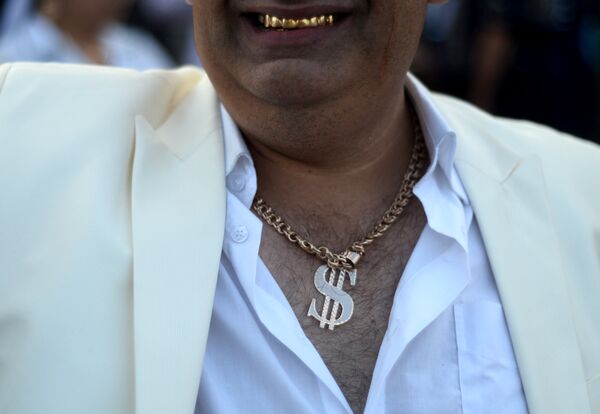The price of gold has risen by more than 30 percent since the start of 2020 as investors move cash into the precious metal amid concern over the global economy and tension between Beijing and Washington.
The price of silver and other precious metals has also gone up but gold holds a special place in most cultures around the world.
Even as #gold builds support just above $2,000 most gold stocks have yet to make new highs for the year. Even the staunchest gold bugs will be surprised by how high the price of gold rises, and how quickly it gets there. A Wile E. Coyote moment for the dollar is fast approaching.
— Peter Schiff (@PeterSchiff) August 4, 2020
Sputnik decided to take a look at what some of the lesser known aspects of gold.
What Is A Tael?
The gold price in Hong Kong closed at 19,060 Hong Kong dollars (US$2,459) per tael on Friday, up on the previous day, according to the Chinese Gold and Silver Exchange Society.
While western gold merchants refer to the price per ounce, in Asia the official measure is a tael.
One tael is equivalent to 1.333 ounces.
Hong Kong Shanghai Banking Corp. #gold one tael 37.5grams. circa. 1970-80. pic.twitter.com/ElSK7WfpWw
— GoldSilverMoney (@au999ag) March 29, 2020
China did not have a recognised national currency before 1933 and most trade was conducted in gold or silver, measured by taels.
The weight of a tael varied considerably in China but the most important was the Shanghai tael, which weighed 518 grains of silver.
Shanghai was the most important international trading city in China and the value of its taels rose and fell depending on the price of silver in London and New York.
How Much Gold Is Left To Be Dug Up?
Mankind has been mining and refining gold for more than 6,000 years.
Remarkably half of the gold ever mined has been recovered since 1967, which shows that modern industrial mining technology has massively sped up the consumption of this finite resource.
The World Gold Council says around 190,000 tons of gold has been mined in the last 6,600 years but it estimates 23 percent of the world’s total gold reserves are still out there waiting to be dug up.
On Friday, 7 August, the world’s eighth biggest gold mining firms - AngloGold Ashanti - reported a 200 percent increase in earnings, boosted by higher gold prices and cost-cutting measures.
AngloGold’s CEO, Kelvin Dushnisky said: "The business is in excellent shape - cash flows are extremely robust, demonstrating the significant operating leverage we have to this strong gold price."
AngloGold has pulled out of South Africa entirely but is putting new investment into its Obuasi Gold Mine in Ghana, which was known as the Gold Coast until 1957.
#Gold ratio comparative to the S&P 500
— Gab (@TraderGab) August 6, 2020
Back in 2011, when gold was almost $2000,
the ratio was 1.7
In 2020 with the price of #gold above $2000,
the ratio is only at 0.62
which means that gold can almost triple in term of that ratio pic.twitter.com/d7fXukkoEP
The world’s deepest gold mine, at Mponeng in South Africa, suspended operations in May after 196 workers tested positive for the coronavirus.
South Africa - once the world’s biggest supplier of gold - has fallen to eighth place in the world.
China, Australia and Russia now produce most of the world’s supply but with gold prices staying high it remains commercially viable to dig new mines, such as Yaramoko in Burkina Faso, which is owned by a Canadian firm, Roxgold.
In the future there is even the possibility of the big companies switching to seafloor mining as land sources become exhausted.
Why Do Indian Families Keep Gold?
The World Gold Council estimates Indian families around the world are sitting on a hoard of gold worth US$1.5 trillion.
In Indian culture - especially in the Hindu community - gold jewellery is often worn on special occasions and is often given as a gift at weddings or other ceremonies.
Manu - a significant character in the Hindu Vedas - decreed that gold should be worn during ceremonies and festivals such as Diwali.
Gold jewellery often makes up the dowries for women and is also inherited when a mother or grandmother passes away.
Sadly the criminal fraternity in Britain, Canada and other countries with a large Indian diaspora have become aware of this and often target Asian homes for burglaries.
Gold also plays a financial role in India, counting as an insurance policy or a retirment plan in a country where welfare payments are unreliable.
Many Indian banks and lenders will also accept gold as collateral for business loans and mortgages.
Was Boer War Triggered By Gold War?
Between 1899 and 1902 the British Empire fought a bitter conflict with the Boers, Afrikaans-speaking settlers in southern Africa.
The Boers showed considerable resistance and at one point 500,000 British soldiers were thrown into the fight.
But why did the British empire spend so much money - an estimated £200 million - forcing the Transvaal and the Orange Free State to submit and become part of the union of South Africa?
Because of gold.

Cecil Rhodes - the highly controversial mining tycoon and imperialist - was determined to bring the Transvaal to heel because it sat atop one of the richest gold seams in the world, the Witwatersrand, which was discovered in 1886.
Four years after bankrolling the failed Jameson Raid, Rhodes and diamond and gold entrepreneurs known as Randlords managed to persuade the British government to go to war, supposedly in support of a few thousand English settlers, known as “uitlanders”, who were living in the Johannesburg area.
After Britain’s victory in the war the number of gold mines in the Witwatersrand increased from 12 to 68 and the value of gold mined rose from £1 million to £19 million.
Rhodes, by then possibly the richest man on the planet, died in March 1902 aged just 48.
Gold Has Medical Properties
Around 10 percent of the world’s total consumption of gold is used in dentistry, pharmacology and cosmetic surgery.
Aside from gold teeth and other dental applications, gold is also used for medical reasons.
In fact its medicinal properties have been known since ancient times.
In the 16th century Swiss alchemist Paracelsus used “potable gold” to treat syphilis and mental illness.
David de Planis-Campy, doctor to King Louis XIII of France, created a “longevity elixir” which contained a gold solution in water.
Gold power or tablets have been used in India for many years and in Japan fine gold foil is sometimes added to tea or sake.
Those who swear by its healing properties, claim gold can destroy bacteria, strengthen the body and improve the immune system.
In 2016 a team of Chinese and Australian researchers published a study in the chemistry journal Angewandte Chemie suggested gold nanoparticles could be used to reduce the number of injections needed to treat age-related macular degeneration, a common form of blindness.




